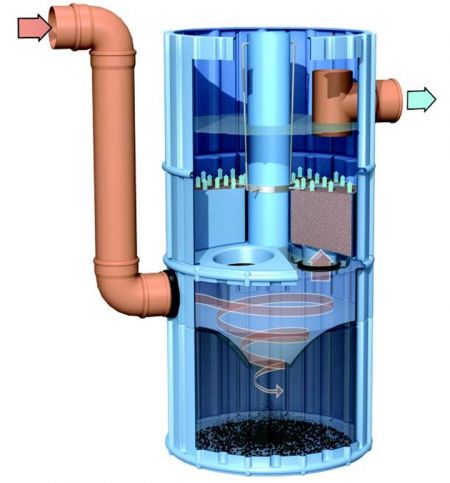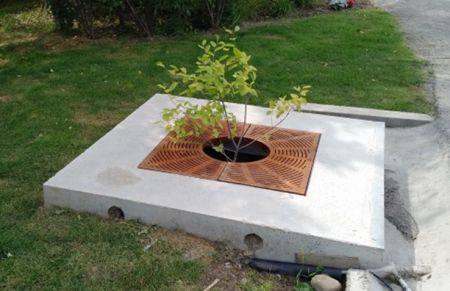Difference between revisions of "Filtration Manufactured Treatment Devices"
| Line 15: | Line 15: | ||
Further guidance on how the data and information generated from verified laboratory testing of OGS technologies should be interpreted and factored into regulatory agency approvals and procurement decisions for stormwater management is provided in this publicly available specification [https://sustainabletechnologies.ca/app/uploads/2023/07/SETV-Guidance-PAS-2023-07-27-English.pdf '''Guidance on the Use and Application of Results from | Further guidance on how the data and information generated from verified laboratory testing of OGS technologies should be interpreted and factored into regulatory agency approvals and procurement decisions for stormwater management is provided in this publicly available specification [https://sustainabletechnologies.ca/app/uploads/2023/07/SETV-Guidance-PAS-2023-07-27-English.pdf '''Guidance on the Use and Application of Results from | ||
Verified Laboratory and Field Testing for Stormwater Manufactured Treatment Devices'''], developed by TRCA and the [https://www.scc.ca/ Standards Council of Canada] that addresses both OGS and Filtration MTDs. | Verified Laboratory and Field Testing for Stormwater Manufactured Treatment Devices'''], developed by TRCA and the [https://www.scc.ca/ Standards Council of Canada] that addresses both OGS and Filtration MTDs. | ||
| − | |||
| − | |||
==Testing and Verification== | ==Testing and Verification== | ||
Revision as of 23:23, 6 February 2024

Overview[edit]
Filtration Manufactured Treatment Devices (MTDs) are structures with one or more chambers containing filtration media, membranes and/or filtration cartridges that remove solids and debris/trash from runoff. Some units may have oil separation functions and pretreatment chambers for coarse sediment and debris. The filter components are designed to remove the coarse and fine sediment fraction of suspended solids and associated pollutants in stormwater runoff and may also target removal of dissolved pollutants such as phosphorus or metals through biological and/or chemical processes.

Application[edit]
Filtration MTDs are suitable for pre-treatment or may be installed as stand alone if third party performance testing shows that they achieve enhanced level water quality protection (i.e. lower 95th percentile removal efficiencies of 80% or greater).
Since Filtration MTDs contain filters that restrict flow rates, they are normally designed for much lower hydraulic loading rates than Oil-Grit Separator MTDs and have longer detention times. Flow restriction occurs due to the small pore size openings of filters and the clogging of pores and/or the formation of films either on the surface of the filter or within the filter matrix filter. For this reason, inspection and maintenance intervals for Filtration MTDs are normally shorter than for OGS MTDs. The method of maintenance typically involves sediment removal with a hydro vacuum truck as well as filter cleaning or replacement.
Further guidance on how the data and information generated from verified laboratory testing of OGS technologies should be interpreted and factored into regulatory agency approvals and procurement decisions for stormwater management is provided in this publicly available specification [https://sustainabletechnologies.ca/app/uploads/2023/07/SETV-Guidance-PAS-2023-07-27-English.pdf Guidance on the Use and Application of Results from Verified Laboratory and Field Testing for Stormwater Manufactured Treatment Devices], developed by TRCA and the Standards Council of Canada that addresses both OGS and Filtration MTDs.
Testing and Verification[edit]
Testing of Filtration MTD performance must be based primarily on field monitoring. Field testing is particularly important for Filtration MTDs because stormwater sediments consist of a mixture of cohesive silts, clay, sand, and may include organic matter, emulsified oils, fine debris, bacteria and other pollutants that build up on filter surfaces and/or penetrate into the filter structure(s) resulting in clogging dynamics that may vary significantly across different filtration system designs. These clogging processes are not easily replicated in laboratory testing due to limitations on the type of test sediment that is used (non-cohesive ground silica) and other factors.
Field testing also allows for a more accurate assessment of filter performance for stormwater pollutants other than suspended solids. These pollutants are subject to complex physical, chemical, and biological interactions that are not easy to replicate in a laboratory.
In Canada, the Canadian Procedure for Field Testing of Filtration Manufactured Treatment Devices, developed by TRCA and the Standards Council of Canada stipulates field testing requirements for Filtration MTDs. This document was developed based on the Technology Assessment Protocol – Ecology (TAPE). TAPE provides a robust and scientifically defensible field evaluation methodology for proprietary and non-proprietary stormwater treatment technologies that is well regarded by stormwater practitioners, having been developed and continuously updated over the past two decades through an extensive third-party expert peer review process. It should be noted that several jurisdictions in Canada do not accept filtration MTDs without field monitoring due to the aforementioned concerns, even if a lab test has been verified through the ISO 14034 ETV process.
- ↑ 3P Technik UK Ltd. 2023. HYDROSYSTEM1000 SUDS MULTI-PROCESS TREATMENT DEVICE. Multi-process SUDS Treatment Device Stages. Accessed: https://www.3ptechnik.co.uk/stormwater-treatment/hydrosystem_1000/
- ↑ STEP. 2020. Performance Evaluation of a High Rate Treatment Bioretention Filter Multi-process SUDS Treatment Device Stages. Technical Brief. Accessed: https://sustainabletechnologies.ca/app/uploads/2020/06/High-rate-treatment-bioretention-filter-tech-brief.pdf